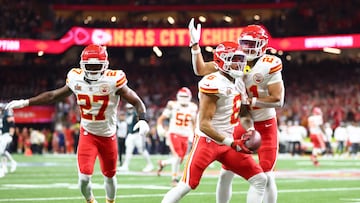How many quarters are there in a game of football?
Super Bowl LIX, Eagles vs Chiefs and we take a look at how games are divided up, how long they last and what happens if there is a tie.

Most professionally-played sports have an interval when those taking part, and sometimes those watching from the stands as well, have a chance to get their breath back. American Football is no exception. NFL games are scheduled to be played in one hour but usually go on for much longer - the average NFL game takes 3 hours and 12 minutes from start to finish while the average college football game takes 3 hours and 24 minutes to be completed.
You might also enjoy
How many quarters in one NFL game?
American Football games are divided into four 15-minute periods or quarters, separated by a 12-minute break at half-time. There are also two-minute breaks at the end of the first and third quarters as teams change over ends after every 15 minutes of play.
At the end of the first and third quarters, the team with the ball retains possession heading into the next quarter. However, that is not the case before half-time. The second half starts with a kickoff in the same direction as the game began in the first quarter. The clock stops at the end of incomplete passing plays, when a player goes out of bounds, or when a penalty is called. The clock starts again when the ball is re-spotted by an official. Between the second and third quarters, there is an intermission of 13 minutes. During this intermission, play is suspended, and teams may leave the field.
END OF THE FIRST QUARTER.
— NFL (@NFL) February 10, 2025
📺: #SBLIX on FOX
📱: Tubi + NFL app pic.twitter.com/07b0QT04Qc
What if there is a tie?
In the event the score is tied at the end of the regulation playing time (four periods - one hour), the game is extended by an overtime period (or periods) of 10 minutes*.
Related stories

The NFL's new rule around the Tush Push

Why Dotson’s TD wasn’t a TD
Once regulation time has been completed, following a three-minute intermission, an extra period of 10 minutes starts. Each team is entitled to two timeouts during each period of overtime. Overtime continues until there is a winner. During the 2022 season, 20 games were taken to overtime, compared to 21 during the 2021 season.
Jalen to Jahan to set up the opening score 🙌
— NFL (@NFL) February 10, 2025
📺: #SBLIX on FOX
📱: Tubi + NFL app pic.twitter.com/bGAl2FioEb
Overtime rules for NFL regular season
- Super Bowl overtime rules
At the end of regulation, the referee will toss a coin to determine which team will possess the ball first in overtime. The visiting team captain will call the toss.
Each overtime period is 15 minutes long. Each team must possess, or have the opportunity to possess, the ball.
The only situation in which both teams would not get a possession would be if the team on defense first scores a safety. In that case, the safety would win the game.
If the score is still tied at the end of an overtime period — or if the second team’s initial possession has not ended — the teams will play another overtime period. Play will continue regardless of how many overtime periods are needed for a winner to be determined.
There will be a two-minute intermission between each overtime period. There will not be a halftime intermission after the second period.
Overtime rules for NFL postseason
- If the game is still tied after four quarters of overtime, there will be another coin toss and play will continue like it’s the first quarter of a new game, a game in which the first team to score wins.
The captain who lost the first overtime coin toss will either choose to possess the ball or select which goal his team will defend, unless the team that won the coin toss deferred that choice.
Each team gets three timeouts during a half.
The same timing rules that apply at the end of the second and fourth regulation periods also apply at the end of a second or fourth overtime period.
If there is still no winner at the end of a fourth overtime period, there will be another coin toss, and play will continue until a winner is declared.
*The overtime system has been in place since its introduction to regular season games in 1974. In 2017, the overtime period was shortened from 15 to 10 minutes

Complete your personal details to comment